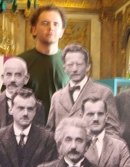Dr. Frank E. S. Steinhoff
 Postdoc
Postdoc
Room: B-106
Phone: +49 271 740 3774
Preprints
See also arxiv
F. E. S. Steinhoff, M. C. de Oliveira
Violations of complementarity enable beyond-quantum nonlocality, distinguishability and cloning
 arXiv:
1406.1710
arXiv:
1406.1710
We consider the consequences of hypothetical violations of the principle of complementarity. For two-level systems, it is shown that any preparation violating complementarity enables the preparation of a non-signalling box violating Tsirelson s bound. Moreover, these superquantum objects could be used to distinguish a plethora of non-orthogonal quantum states and hence enable improved cloning protocols. For higher-dimensional systems the main ideas are briefly sketched.
F. E. S. Steinhoff
Nonclassicality witnesses and entanglement creation
 arXiv:
1204.1794
arXiv:
1204.1794
Several definitions of classicality are considered, such as P-representability, generalized coherent states and separable states. These notions are treated under a simple and general definition based on convex sets, which enables the use of the Hahn-Banach theorem to separate classical states from nonclassical ones. Nonclassicality linear witnesses are constructed, based on the observables available in a given physical situation. Some examples of nonclassical states are considered, with detection schemes available nowadays. Reviewing the concept of entanglement potential from a different perspective, it is shown that in some contexts an arbitrary single-system nonclassical state can be converted into a bipartite entangled state, provided a generalized controlled-displacement (e.g., beam-splitter, CNOT gate) is available. Also, this entanglement can be detected in a simple way using the nonclassicality witness of the original single-system state. Finally, we extend the discussion to multipartite states, proposing alternative ways to generate and classify multipartite entanglement.
Publications
O. Gühne, M. Cuquet, F.E.S. Steinhoff, T. Moroder, M. Rossi, D. Bruß, B. Kraus, C. Macchiavello
Entanglement and nonclassical properties of hypergraph states
 J. Phys. A: Math. Theor.
47
,
335303
(
2014
),
arXiv:
1404.6492
J. Phys. A: Math. Theor.
47
,
335303
(
2014
),
arXiv:
1404.6492
Hypergraph states are multi-qubit states that form a subset of the locally maximally entangleable states and a generalization of the well--established notion of graph states. Mathematically, they can conveniently be described by a hypergraph that indicates a possible generation procedure of these states; alternatively, they can also be phrased in terms of a non-local stabilizer formalism. In this paper, we explore the entanglement properties and nonclassical features of hypergraph states. First, we identify the equivalence classes under local unitary transformations for up to four qubits, as well as important classes of five- and six-qubit states, and determine various entanglement properties of these classes. Second, we present general conditions under which the local unitary equivalence of hypergraph states can simply be decided by considering a finite set of transformations with a clear graph-theoretical interpretation. Finally, we consider the question whether hypergraph states and their correlations can be used to reveal contradictions with classical hidden variable theories. We demonstrate that various noncontextuality inequalities and Bell inequalities can be derived for hypergraph states.
F. E. S. Steinhoff, M. C. de Oliveira, J. Sperling, W. Vogel
Bipartite bound entanglement in continuous variables through deGaussification
 Phys. Rev. A
89
,
032313
(
2013
),
arXiv:
1304.1592
Phys. Rev. A
89
,
032313
(
2013
),
arXiv:
1304.1592
We introduce a class of bipartite entangled continuous variable states that are positive under partial transposition operation, i.e., PPT bound entangled. These states are based on realistic preparation procedures in optical systems, being thus a feasible option to generate and observe genuinely bipartite bound entanglement in high precision experiments. One fundamental step in our scheme is to perform a non-Gaussian operation over a single-mode Gaussian state; this deGaussification procedure is achieved through a modified single-photon addition, which is a procedure that has currently being investigated in diverse optical setups. Although dependent on a single-photon detection in a idler channel, the preparation can be made unconditional after a calibration of the apparatus. The detection and proof of bound entanglement is made by means of the Range Criterion, theory of Hankel operators and Gerschgorin Disk s perturbation theorems.
F. E. S. Steinhoff, M. C. de Oliveira
Families of bipartite states classifiable by the positive partial transposition criterion
 Quant. Inf. Comput.
10, No. 5 and 6
,
525
(
2010
),
arXiv:
0906.1297
Quant. Inf. Comput.
10, No. 5 and 6
,
525
(
2010
),
arXiv:
0906.1297
We construct a family of bipartite states of arbitrary dimension whose eigenvalues of the partially transposed matrix can be inferred directly from the block structure of the global density matrix. We identify from this several subfamilies in which the PPT criterion is both necessary and sufficient. A sufficient criterion of separability is obtained, which is fundamental for the discussion. We show how several examples of states known to be classifiable by the PPT criterion indeed belong to this general set. Possible uses of these states in numerical analysis of entanglement and in the search of PPT bound entangled states are briefly discussed.
F. E. S. Steinhoff, M. C. de Oliveira
State reconstruction of finite dimensional compound systems via local projective measurements and one-way classical communication
 Phys. Rev. A
82
,
062308
(
2010
),
arXiv:
0903.3249
Phys. Rev. A
82
,
062308
(
2010
),
arXiv:
0903.3249
For a finite dimensional discrete bipartite system, we find the relation between local projections performed by Alice, and Bob post-selected state dependence on the global state submatrices. With this result the joint state reconstruction problem for a bipartite system can be solved with strict local projections and one-way classical communication. The generalization to multipartite systems is straightforward.

